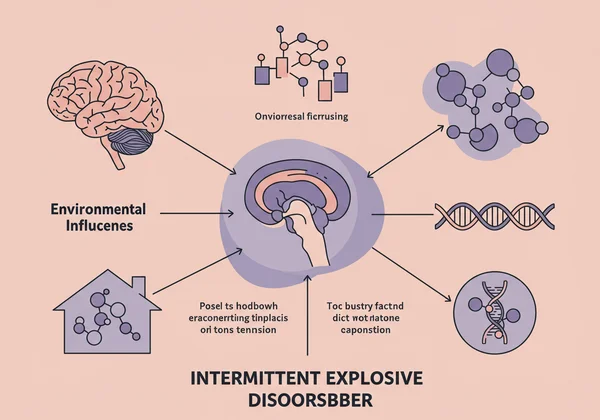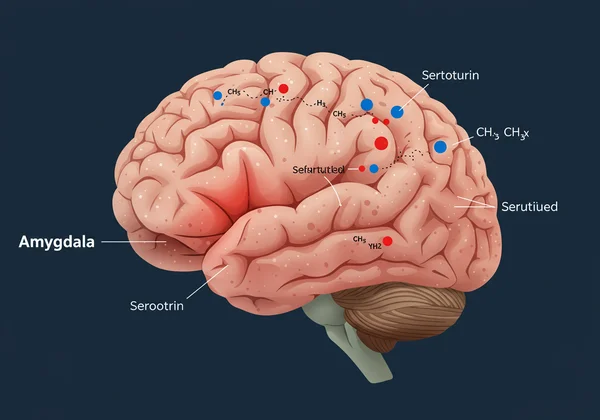간헐성 폭발 장애: 분노의 원인 이해하기
갑작스럽고 통제 불가능한 분노 폭발을 경험하는 것은 두렵고 혼란스러운 일일 수 있습니다. 상황에 비해 감정이 지나치게 격렬하다고 느끼며, 이후 죄책감과 수치심에 시달릴 수 있습니다. 만약 "왜 나에게 이런 일이 일어나는 걸까?" 라고 자문해 본 적이 있다면, 당신은 혼자가 아닙니다. 이 질문은 이해를 향한 첫걸음입니다. 이 글은 간헐성 폭발 장애(IED) 의 복잡한 기원을 깊이 다루며, 이 어려운 상태에 기여하는 생물학적, 심리적, 환경적 요인들을 조명합니다. 이러한 근본 원인을 이해하는 것은 자신을 통제하고 적절한 지원을 찾는 데 있어 매우 중요한 단계입니다.
많은 사람들에게 여정은 자기 성찰에서 시작됩니다. 자신의 감정 패턴에 대한 초기 통찰력을 얻는 것은 도움이 될 수 있습니다. 무료, 기밀 평가는 전문가의 안내를 받기 전에 자신의 경험을 탐색할 수 있는 사적인 공간을 제공하며, 이 과정을 시작하는 구조화된 방법을 제공할 수 있습니다.

간헐성 폭발 장애의 생물학적 기초 (IED 원인)
폭발적인 분노는 개인적인 잘못처럼 느껴질 수 있지만, 생물학이 종종 큰 역할을 한다는 것을 기억하는 것이 중요합니다. IED의 기반은 종종 우리의 타고난 신경 생물학 및 유전적 구성과 관련이 있습니다. 이것은 선택이 아니라, 일부 사람들에게는 감정 조절을 더 어렵게 만드는 경향성입니다. IED의 생물학적 근거를 이해하는 것은 낙인을 제거하고, 그것이 합법적인 건강 상태임을 보여주는 데 도움이 됩니다.
유전적 소인 및 가족력: IED는 유전되는가?
가장 흔한 질문 중 하나는 폭발적인 분노 성향이 세대를 거쳐 유전될 수 있는지 여부입니다. 연구에 따르면 충동성과 공격성에 대한 유전적 소인 이 실제로 존재합니다. 가족 및 쌍둥이 연구는 IED가 상당한 유전적 요소를 가지고 있음을 시사합니다. 폭발적인 성격이나 충동 조절 장애로 어려움을 겪는 가까운 친척이 있다면, 자신의 발병 가능성이 더 높을 수 있습니다. 이것이 IED가 필연적이라는 것을 의미하지는 않지만, 특히 다른 위험 요인과 결합될 때 일부 개인은 이 질환을 발달시킬 가능성이 더 높게 태어날 수 있음을 시사합니다.
신경학적 요인: 뇌의 차이 및 화학적 불균형
유전학을 넘어 신경학적 요인 은 IED를 이해하는 데 핵심적인 역할을 합니다. 뇌는 감정이 조절되는 곳이며, 그 구조와 화학적 성분의 미묘한 차이조차도 큰 영향을 미칠 수 있습니다. 두 가지 주요 영역이 종종 관련이 있습니다.
- 편도체: 이 뇌의 영역은 위협 탐지기 역할을 합니다. IED 환자의 경우, 편도체가 과활성화되어 다른 사람에게는 위협으로 인식되지 않는 상황을 위협으로 인지하게 하여, 빠르고 격렬한 "투쟁 또는 도피" 반응을 유발할 수 있습니다.
- 전두엽 피질: 이것은 추론, 충동 조절 및 사회적 행동 조절을 담당하는 뇌의 실행 중심입니다. IED 환자의 경우, 전두엽 피질이 덜 활동적이거나 편도체와의 연결이 약해져 진정하고 공격적인 충동을 억제하는 것을 더욱 어렵게 만들 수 있습니다.
뇌 화학 물질, 특히 세로토닌의 불균형 또한 기여하는 것으로 여겨집니다. 세로토닌은 기분을 조절하고 충동적인 행동을 억제하는 데 도움이 되는 신경전달물질입니다. 낮은 세로토닌 수치는 공격성 증가 및 감정 조절의 어려움과 연관성이 있는 것으로 나타났습니다.

폭발적인 분노의 환경 및 심리적 요인
생물학은 소인을 만들 수 있지만, 우리의 삶의 경험과 심리적 구성은 우리가 분노를 표현하는 방식을 진정으로 형성합니다. 많은 사람들에게 폭발적인 분노 패턴은 자신이 성장한 환경과 시간이 지남에 따라 개발된 대처 기술에 의해 형성됩니다. 이러한 요인은 비난이 아니라, 과거가 현재 반응에 어떻게 영향을 미치는지를 이해하는 데 있습니다.
어린 시절 트라우마 및 역경의 영향
어린 시절 트라우마 에 노출되는 것은 IED의 가장 중요한 환경적 위험 요인 중 하나입니다. 언어적 또는 신체적 학대가 있는 가정에서 자라거나, 폭력을 목격하거나, 방치 경험을 하면 발달 중인 뇌에 지대한 영향을 미칠 수 있습니다. 이러한 역경은 아이에게 세상이 적대적인 장소이며 공격적인 폭발이 반응하는 정상적이거나 불가피한 반응이라고 학습하게 할 수 있습니다. 이는 과잉 경계 상태로 이어지고 성인기에 스트레스에 과도한 분노로 반응하는 고착된 패턴을 유발할 수 있습니다.
학습된 행동: 공격성 모델링 및 대처 메커니즘
우리의 가장 초기 관계는 종종 우리 자신의 행동에 대한 청사진 역할을 합니다. 아이들이 부모나 다른 권위 있는 인물이 좌절에 폭발적인 분노로 반응하는 것을 관찰한다면, 어려운 감정을 다루는 주요한 방식으로 이러한 학습된 행동 을 내면화할 수 있습니다. 건강한 대처 메커니즘(예: 의사소통, 문제 해결 또는 자기 진정)에 노출되지 않으면, 공격적인 폭발은 스트레스나 갈등에 대한 기본적이고 자동적인 반응이 될 수 있습니다.
동반되는 정신 건강 상태의 역할
IED는 거의 홀로 존재하지 않습니다. 종종 다른 정신 건강 문제와 동반됩니다. 이러한 동반되는 정신 건강 상태 는 IED 증상을 악화시키거나 그 발병의 위험 요인이 될 수 있습니다. 흔한 동반 질환은 다음과 같습니다.
- 주의력 결핍 과잉 행동 장애 (ADHD)
- 우울증 및 양극성 장애
- 외상 후 스트레스 장애 (PTSD)를 포함한 불안 장애
- 물질 사용 장애
이러한 상태는 개인의 좌절에 대한 역치를 낮추고, 충동성을 증가시키며, 감정 조절을 더욱 어렵게 만들어 종합적인 접근이 필요한 복잡한 악순환을 야기할 수 있습니다.
자신의 위험 파악: IED 발달에 기여하는 주요 요인
자신의 삶에서 간헐성 폭발 장애 위험 요인 을 인식하는 것은 자기 인식을 위한 중요한 단계입니다. 이를 통해 자신의 경험과 현재의 어려움 사이의 연관성을 파악할 수 있습니다. 여러 주요 요인이 IED 발달 가능성을 높일 수 있으며, 이 중 상당수는 이미 다룬 바 있습니다.
만약 자신의 삶에서 이러한 요인 중 일부를 인식한다면, 명확성을 제공하기 위해 고안된 구조화된 도구를 통해 분노 패턴 탐색을 고려해 보는 것이 도움이 될 수 있습니다.
발병 연령: IED는 나이가 들수록 더 심해지는가?
많은 사람들은 IED가 나이가 들수록 더 심해지는지 궁금해합니다. IED의 증상은 일반적으로 청소년기에 시작되며, 종종 20세 이전에 나타납니다. 치료되지 않은 채로 방치되면, 폭발적인 행동 패턴은 시간이 지남에 따라 더욱 고착될 수 있습니다. 발발의 빈도나 강도가 반드시 증가하지는 않을 수 있지만, 관계 손상, 직업 상실 또는 법적 문제와 같은 결과는 종종 누적되고 악화됩니다. 그러나 그 반대도 마찬가지입니다. 인식과 적절한 치료를 통해 개인은 분노를 관리하고 삶의 질을 개선하는 방법을 배울 수 있습니다.
스트레스, 물질 사용 및 유발 요인의 영향
생물학적 및 환경적 요인이 소인을 만들지만, 현재의 삶의 상황이 종종 폭발적인 분노 폭발을 유발하는 요인이 됩니다. 특히 스트레스는 큰 영향을 미칩니다. 높은 수준의 만성 스트레스는 사람의 대처 능력을 약화시켜 분노 폭발의 가능성을 높입니다. 물질 사용, 특히 알코올은 또 다른 주요 요인입니다. 알코올은 억제력을 낮추고 판단력을 손상시켜 충동적이고 공격적인 충동을 통제하기 매우 어렵게 만듭니다. 개인적인 유발 요인(분노 폭발 전에 발생하는 특정 상황, 사람 또는 감정)을 파악하는 것은 IED 관리의 중요한 부분입니다.
IED에 대한 이해 나아가기: 다음 단계
간헐성 폭발 장애의 원인을 이해하는 것은 변명을 찾는 것이 아니라, 자기 연민의 기반을 구축하고 변화를 위한 로드맵을 만드는 것입니다. 우리는 IED가 유전학, 뇌 화학, 과거의 트라우마 및 학습된 행동의 복잡한 혼합에서 비롯된 복잡한 상태임을 보았습니다. IED는 개인적인 잘못이 아니라, 치료 가능한 정신 건강 상태임을 기억하십시오.
자신의 삶에서 이러한 요인을 인식하는 것이 가장 용감한 첫걸음입니다. 다음은 더 깊이 이해하기 위해 나아가는 것입니다. 이 기사의 내용 중 당신의 경험과 공감되는 부분이 있다면, 안전하고 사적인 단계로 더 깊이 탐색해 보는 것을 고려해 보세요. 의료 전문가와의 대화를 시작점으로 활용할 수 있는 개인화된 통찰력을 얻으려면 무료, 기밀 분노 및 충동성 자가 평가를 통해 첫걸음을 내딛으십시오.

IED 원인에 대한 자주 묻는 질문
간헐성 폭발 장애의 원인은 무엇입니까?
간헐성 폭발 장애(IED)는 생물학적, 환경적, 심리적 요인의 조합으로 인해 발생하는 것으로 여겨집니다. 생물학적으로는 유전학, 뇌 구조의 차이(과활성화된 편도체 및 덜 활성화된 전두엽 피질 등), 세로토닌과 같은 신경전달물질의 불균형과 관련이 있습니다. 환경적으로는 언어적 또는 신체적 학대가 있는 가정에서 자라거나 공격적인 행동을 학습하는 것이 주요 위험 요인입니다.
IED는 나이가 들수록 악화되나요?
치료되지 않은 채로 방치되면, IED의 부정적인 결과는 관계, 경력 및 법적 지위에 대한 누적된 피해로 인해 나이가 들수록 악화되는 경우가 많습니다. 그러나 이 질환 자체는 치료 가능합니다. 치료와 때로는 약물 치료를 통해 개인은 분노와 충동성을 효과적으로 관리하는 방법을 배울 수 있으며, 이는 나이에 관계없이 개입을 통해 예후가 크게 개선될 수 있음을 의미합니다.
IED를 치료하지 않으면 어떻게 되나요?
치료되지 않은 IED는 삶의 모든 영역에 걸쳐 심각한 결과를 초래할 수 있습니다. 관계 단절, 이혼, 직업 상실, 학교 정학, 재정 문제 및 폭행 혐의를 포함한 법적 문제로 이어질 수 있습니다. 또한 자해, 자살 시도, 우울증, 불안 및 물질 남용과 같은 다른 정신 건강 질환의 발병 위험을 증가시킵니다. 이러한 심각한 위험을 완화하기 위해 도움을 구하는 것이 중요합니다.
내가 IED를 앓고 있는지 어떻게 알 수 있나요?
자신이 IED를 앓고 있는지 확실히 알 수 있는 유일한 방법은 자격을 갖춘 정신 건강 전문가로부터 공식적인 진단을 받는 것입니다. 그러나 핵심 징후를 찾아보는 것으로 시작할 수 있습니다. 촉발 요인에 비해 터무니없이 과도한 반복적인 분노 폭발, 언어적 공격 또는 신체적 폭행, 그리고 폭발 중에 안도감이나 해방감을 느끼고 종종 강한 후회나 수치심을 느끼는 것입니다. 분노에 대해 의문이 든다면, 전문가와 상담하기 전에 생각을 정리하는 데 유용한 첫 단계로 기밀 간헐성 폭발 장애 검사를 받을 수 있습니다.